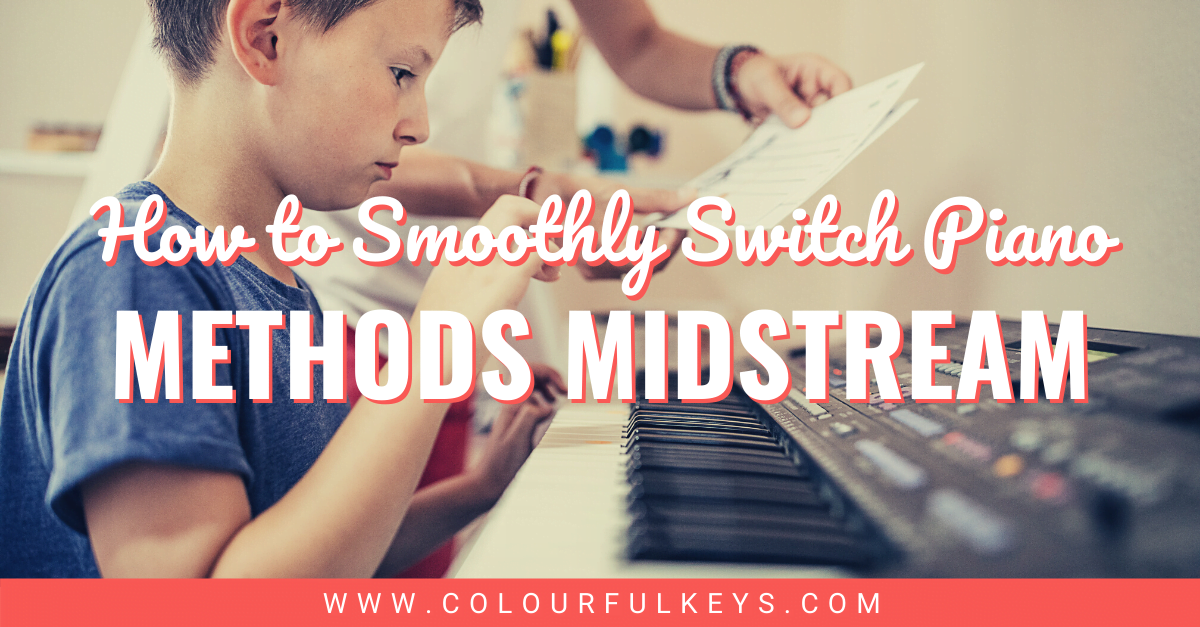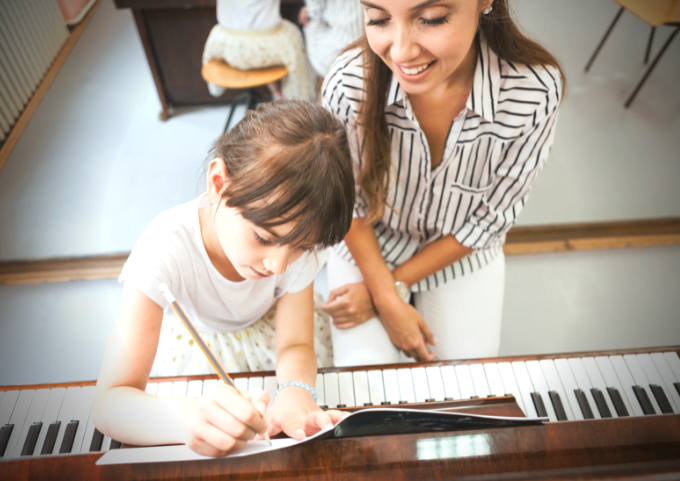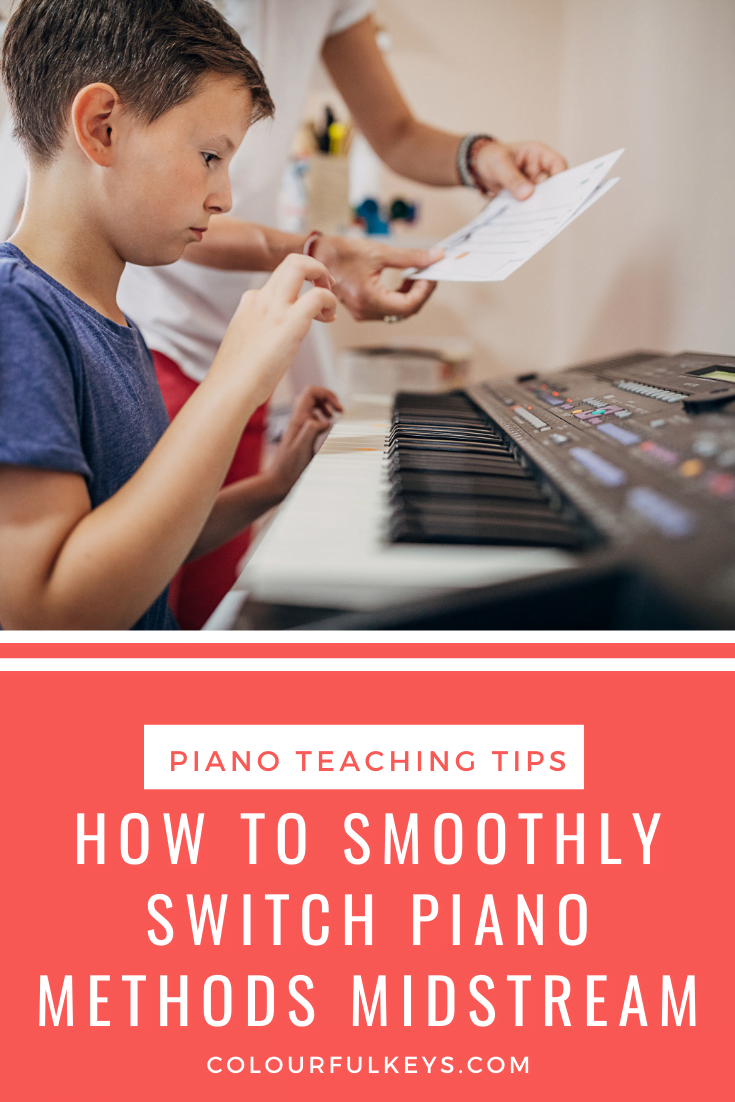Have you ever let out a sigh when a transfer student comes to you with certain piano method books? Or discovered partway through that a particular series just isn’t going to work for a student? Let me help smooth out the switch to more suitable piano methods. ☺️

⬆️ Listen to the podcast above or keep on reading, whichever fits your style. ↙️
Finding the right method for your piano students is hard enough anyway. But what do you do when a transfer student comes to you with a method which you don’t know? Or even one which you kinda sorta…despise with the passion of a supernova?
Even worse is when YOU picked out the original method and had parents go and buy it, only to discover it’s not a good fit partway through. 😳
It’s not an ideal situation, I’ll give you that. But we don’t need to panic.
Let’s put on our down-to-business hat and tackle this thing head-on.
Back to a Blank Slate
I’m not saying you should pull a student back to the beginning. Just pretend they don’t have a method book at all for a moment.
If you had a student with their level of reading and playing abilities, which book would you use with them? If nothing else was standing in the way, what would you choose?
Sometimes we’re reluctant to place a student at the beginning of a method if they’ve been learning for a while. Or we may want to stick with the books they’re in because we don’t want to ask the parents to purchase another set.
But ultimately, it ends up being a false economy.
Saving the parents a few bob isn’t worth anything if we’re holding their kiddo back from making good progress. And if we approach it the right way, making the switch to new piano methods doesn’t need to feel like a step backward.

So, I’ll ask again – if nothing else were on the table, which book would you use with this student?
Be a Method Book Matchmaker
That’s not always a simple question to answer, so let’s walk through 4 method-book-matchmaking factors together.
Skill Gaps
Most piano students have some weaker areas. Heck, most teachers do too, right? It’s only natural.
Many piano methods are stronger on one aspect than others. You’ll to want to take this into consideration when choosing which one to switch to.
- If this student needs a lot of improv and you’re not comfortable adding it yourself, is improv included in the method?
- Does the student need an interval reset to get comfortable with reading?
- Do they need lots of practice with quavers (eighth notes) and, if so, are those reinforced enough in this method?
If you’re not sure where your student’s gaps are, the Student Sleuth is a great place to figure this out before changing piano method books.
Student’s Goals
Your student’s goals should have a big role to play in what music method you switch them to, especially if they’re an older beginner.
With a young student, you’ll want a method book for beginners which helps you lay the strongest foundation you can in every area. That way they can go whatever direction they choose later as their tastes evolve.
Older students need that strong foundation too, but you won’t get to lay it if they’re not engaging with the music. So genre preferences play a much bigger role here.
Just imagine you took up the Guzheng (Chinese table harp) tomorrow. Would you stick with lessons if your teacher taught you Mary Had a Little Lamb, The Barney Song and My Little Pony?
Not for long.
It’s fine to do beginner pieces with adults and teens, but they don’t have to be childish. Make sure you’re listening to their goals and what they like before choosing a course of study.
Method Style
The pedagogy, sequencing and music are important, but the look of a method book might matter more than you think.
For certain students, especially those with learning differences, having cluttered pages can stand in the way of their learning. Even if the method is perfect for them in every other way, they may not be able to see past the cartoons.
Keep the overall style of the book in mind as you make this decision and make sure it won’t be:
- Too busy…
- Too childish…
- Too dry…
…for your particular student.
Level-Alike
Once you have a method book in mind, you’re left with a big question: Where should you place this student in this method?
More than likely, they’re currently partway through some other book. And even if they were right at the end, level 1 of one method isn’t the same as level 1 in another. 🤔

Some method book publishers provide conversion charts on their site but, because of the variation in how they move through concepts, this only provides a rough idea. For example, your student could’ve struggled with rhythm and the new method may move a little faster in that area, so the chart would give you a skewed picture.
When in doubt, go easy.
When changing piano method books, it’s better to go back further than you might need to. If a student ends up sight-reading the first few pieces or has a few easier practice weeks, that’s no big deal. But if the first few pieces are a struggle you’re going to have a hard time getting them to love the switch between these piano methods.
Take Your Time with Transfer Students
There’s no need to rush and switch piano methods as soon as your students start lessons. You both need time to get comfortable with each other, build rapport and for you to figure out what makes your student tick.
If you have a new transfer student who is somewhere in their first couple of years of study, Online from the Outset would be a great grab-and-go option. You don’t have to be teaching online to use those plans and the student doesn’t need to be brand new.
If that won’t work, here’s a breakdown of the 3 different elements you should include in your transfer student’s lessons before you switch piano methods.
1. Play Piano Teaching Games
Games are an awesome way to assess students’ learning without it feeling like a test.
Here are 6 areas to investigate with your new student where games really come in handy, along with a couple of Vibrant Music Teaching games for each area:
- Intervals – Pianterval and Interval Shminterval Sprinterval
- Note names – Double or Nothing and Swoop at Sight
- Terms – Termboggan and Pit Stop
- Rhythm – Any exercise from Rhythm in 5
- Ear training – Hexatonic Pattern Cards and Sidestep Solfa
- General staff knowledge – Staffsaw and Musical Cadets
This is just a starting point. If your student needs to focus more on one of these areas, there are plenty more games in the Vibrant Music Teaching Library to cover those topics.
2. Include Rote Repertoire
The other thing you’ll find in my Online from the Outset plan is original rote pieces. If these are too easy for your student, you may want to supplement with other pattern pieces. You can find lots of great ones in Piano Safari’s Pattern Pieces 1 and Pattern Pieces 2 and at RoteRepertoire.com. (Remember to use your discounts if you’re a member of Vibrant Music Teaching!)
If rote teaching makes you nervous, here are 5 simple tips to arm yourself with so you can add this approach to your teaching toolbox.
3. Explore Your Music Library
Before changing a student’s music method book, You may also want to include little tastes of methods and general repertoire reading in your transfer student’s lessons.
Pick out random books at each lesson and spend no more than 5 minutes having your student sight read a couple. If they have duet parts, definitely do them as duets!
This will allow you to gauge their reading level and interests so you can match them with a method or collection when the time comes.
Visit my centralised hub page on Planning Piano Lessons for more help incorporating these elements.
Supplement to Success
Sometimes the least disruptive thing to do is to just not change their current piano method at all, especially if the student is used to the method and enjoys learning. There are always gaps in any method you choose – this could be an opportunity for you to explore a new method together or to think outside the box for materials to supplement.
Cover Your Bases
You might decide that it’s better overall to put them through a general musicianship course alongside their current method. These would all be great choices to add to their method book to enrich their musical journey:
- Tiny Finger Takeoff for young students
- Piano Powerbooster One for students in their first or second year
- Piano Powerbooster Two for students in their second or third year
- Piano Powerbooster Three for students in their fourth year or beyond
Another great way to supplement is to use bits of another method. You can do this by loaning the method book to your student or by using elements like the Piano Safari Sight Reading Cards or a supplemental technique book.
How do you go about changing a piano student’s method book?
I’d love to hear your experience with this in the comments below. 🙂
